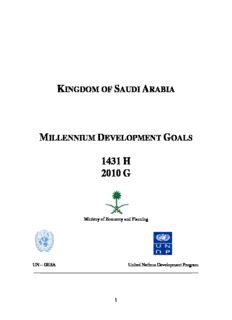
kingdom of saudi arabia millennium development goals 1431 h 2010 g PDF
Preview kingdom of saudi arabia millennium development goals 1431 h 2010 g
K S A INGDOM OF AUDI RABIA M D G ILLENNIUM EVELOPMENT OALS 1431 H 2010 G Ministry of Economy and Planning UN – DESA United Nations Development Program ______________________________________________________________ 1 1431/7221 ﻉﺍﺩﻴﻹﺍ ﻡﻗﺭ ISSN 1658-2691 ﺩﻤﺩﺭ 2 IN THE NAME OF GOD THE COMPASSIONATE THE MERCIFUL 3 4 CONTENTS Page List of Abbreviations and Acronyms 7 Introduction 9 Overview of the Monitoring and Evaluation Environment 13 Overview of the Progress Achieved 15 Economic and Social Framework 19 Goal 1: Eradicate Extreme Poverty and Hunger 29 Goal 2: Achieve Universal Primary Education 43 Goal 3: Promote Gender Equality and Empower Women 51 Goal 4: Reduce Child Mortality 63 Goal 5: Improve Maternal Health 71 Goal 6: Combat HIV/AIDS, Malaria and other Diseases 77 Goal 7: Ensure Environmental Sustainability 85 Goal 8: Develop a Global Partnership for Development 97 References 111 5 6 List of Abbreviations and Acronyms AIDS Acquired Immune Deficiency Syndrome HIV/AIDS Human Immunodeficiency Virus/ Acquired Immune Deficiency Syndrome CDSI Central Department of Statistics and Information DOTS Directly Observed Treatment Shortcourse GHA General Housing Authority IDB Islamic Development Bank IMF International Monetary Fund KACST King Abdulaziz City for Science and Technology MDGs Millennium Development Goals MIGA Multilateral Investment Guarantee Agency MOCI Ministry of Commerce & Industry MOEP Ministry of Economy and Planning MOH Ministry of Health OPEC Organization of Petroleum Exporting Countries SFD Saudi Fund for Development T.B. Tuberculosis WFP UN World Food Programme UNDP The United Nations Development Programme 7 8 I NTRODUCTION Over the last two decades, several international summits and conferences were convened, with the aim of formulating a common development vision that would respond to existing needs and would rise to the new challenges; all within a framework of partnership at both the national and international levels. A large number of topics were addressed, including: population, social development, women and gender equality, human settlements, children, the elderly, education, human rights, information technology, and sustainable development. These forums were responsible for producing a substantial momentum for attaining integration of effort and for intensifying action at all levels in order to achieve the stated objectives. International efforts to stress the fundamental links among peace, security and development, as well as to provide a comprehensive vision for development and progress, culminated with the "Millennium Declaration" made by a summit of 147 heads of state, organized by the United Nations in September 2000. Subsequently, a system was developed to monitor progress towards a set of 8 general goals that came to be known collectively as the Millennium Development Goals (MDGs): Eradicate extreme poverty and hunger. Achieve universal primary education. Promote gender equality and empower women. Reduce child mortality. Improve maternal health. Combat HIV/AIDS, malaria and other diseases. Ensure environmental sustainability. Develop a global partnership for development. Twenty-one targets, derived from the general goals, are to be achieved by 2015, and 58 indicators, several for each target, have been developed to monitor implementation and measure progress. 9 Progress towards achieving the MDGs is monitored at both the international and national levels. Every five years, the UN Secretary General submits to the UN General Assembly a comprehensive progress report. At the national level, each country is required to prepare national reports that reflect progress towards achievement of the MDGs. The objective of the national reports, which feature indicators and analysis of progress, is to inform decision-makers and gain their support, and ultimately resulting in the formulation of adequate policies. The reports also serve to involve economic, social, and political institutions and the media, as well as the general public, in local and national efforts to achieve the MDGs. Out of its keenness to adopt the global vision in this regard in accordance with Islamic norms and values, and to monitor progress towards meeting the MDGs, the Kingdom of Saudi Arabia issued its first national report in 2002, followed by a second report in 2006 a third one in 2008 and a fourth one in 2009. The present report is the fifth in the series. All five reports were prepared by the Ministry of Economy and Planning, in close collaboration with the relevant government agencies, and with support from the United Nations Development Program (UNDP) and the United Nations Department of Economic and Social Affairs (UN/DESA) . The report charts the progress made by the Kingdom towards achieving the MDGs at four levels: 1st. Accelerating development of the IT environment, making it possible to speed up achievement of the MDGs, through considerable expansion of databases. 2nd. Integration of the MDGs into sustainable development, as laid out through the development plans in general and the Eighth and Ninth Development Plans in particular. 3rd. Persistent efforts to achieve, even surpass, the MDGs ahead of the schedule set by the UN. 4th. The considerable momentum in development assistance extended by the Kingdom to support MDGs implementation in developing countries. Over the period 1973- 2009, the Kingdom extended more than $99.75 billion in total assistance to developing countries. The amount of aid provided by the Kingdom exceeds the 10
Description: